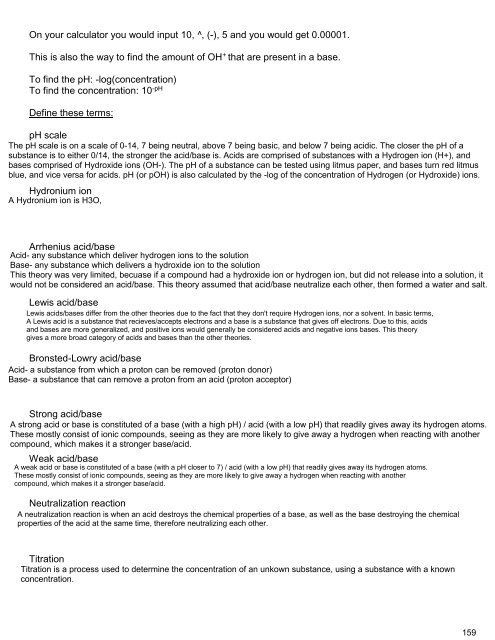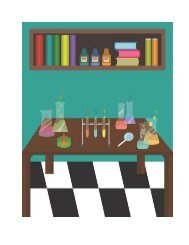(FINAL) Chemistry Notebook 2016-17
- No tags were found...
You also want an ePaper? Increase the reach of your titles
YUMPU automatically turns print PDFs into web optimized ePapers that Google loves.
On your calculator you would input 10, ^, (-), 5 and you would get 0.00001.<br />
This is also the way to find the amount of OH + that are present in a base.<br />
To find the pH: -log(concentration)<br />
To find the concentration: 10 -pH<br />
Define these terms:<br />
pH scale<br />
The pH scale is on a scale of 0-14, 7 being neutral, above 7 being basic, and below 7 being acidic. The closer the pH of a<br />
substance is to either 0/14, the stronger the acid/base is. Acids are comprised of substances with a Hydrogen ion (H+), and<br />
bases comprised of Hydroxide ions (OH-). The pH of a substance can be tested using litmus paper, and bases turn red litmus<br />
blue, and vice versa for acids. pH (or pOH) is also calculated by the -log of the concentration of Hydrogen (or Hydroxide) ions.<br />
Hydronium ion<br />
A Hydronium ion is H3O,<br />
Arrhenius acid/base<br />
Acid- any substance which deliver hydrogen ions to the solution<br />
Base- any substance which delivers a hydroxide ion to the solution<br />
This theory was very limited, becuase if a compound had a hydroxide ion or hydrogen ion, but did not release into a solution, it<br />
would not be considered an acid/base. This theory assumed that acid/base neutralize each other, then formed a water and salt.<br />
Lewis acid/base<br />
Lewis acids/bases differ from the other theories due to the fact that they don't require Hydrogen ions, nor a solvent. In basic terms,<br />
A Lewis acid is a substance that recieves/accepts electrons and a base is a substance that gives off electrons. Due to this, acids<br />
and bases are more generalized, and positive ions would generally be considered acids and negative ions bases. This theory<br />
gives a more broad category of acids and bases than the other theories.<br />
Bronsted-Lowry acid/base<br />
Acid- a substance from which a proton can be removed (proton donor)<br />
Base- a substance that can remove a proton from an acid (proton acceptor)<br />
Strong acid/base<br />
A strong acid or base is constituted of a base (with a high pH) / acid (with a low pH) that readily gives away its hydrogen atoms.<br />
These mostly consist of ionic compounds, seeing as they are more likely to give away a hydrogen when reacting with another<br />
compound, which makes it a stronger base/acid.<br />
Weak acid/base<br />
A weak acid or base is constituted of a base (with a pH closer to 7) / acid (with a low pH) that readily gives away its hydrogen atoms.<br />
These mostly consist of ionic compounds, seeing as they are more likely to give away a hydrogen when reacting with another<br />
compound, which makes it a stronger base/acid.<br />
Neutralization reaction<br />
A neutralization reaction is when an acid destroys the chemical properties of a base, as well as the base destroying the chemical<br />
properties of the acid at the same time, therefore neutralizing each other.<br />
Titration<br />
Titration is a process used to determine the concentration of an unkown substance, using a substance with a known<br />
concentration.<br />
159





